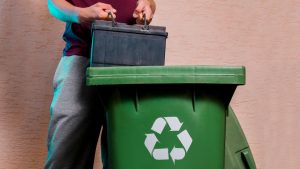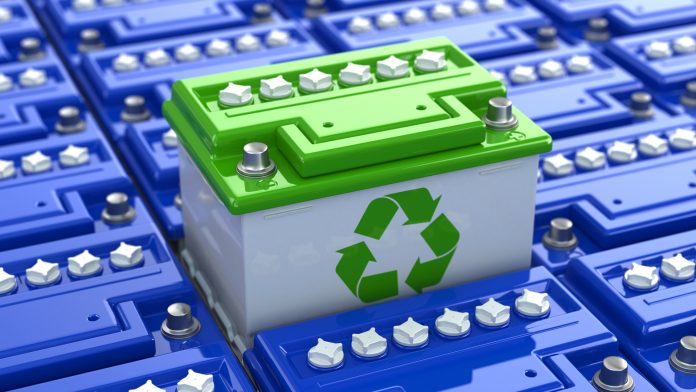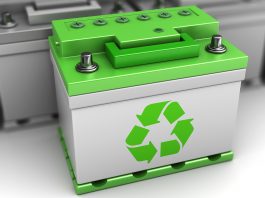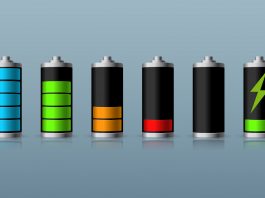Given the importance of improving the entire battery value chain, The Innovation Platform takes a look at the European Recycling Industries’ Confederation’s response to the EU’s Batteries and Waste Batteries Regulation.
The European Recycling Industries’ Confederation (EuRIC) has welcomed the long-awaited proposed Batteries and Waste Batteries Regulation published by the EU Commission on 10 December, 2020, stating: ‘It is a fact that improving the design of batteries – making them more sustainable, readily removable and easily recyclable – is a pre-condition to transition towards a circular economy. It is also part of the solution to tackle acute problems faced by recyclers linked to the ever-increasing battery fires during the collection, transport, and treatment of the booming end-of-life products containing batteries, which pose major problems.’
EuRIC sees the Commission’s proposal as a huge step forward in terms of connecting the dots between the design and end-of-life (EoL) phase of batteries (from design and production to reuse and recycling) while simultaneously minimising their harmful effects on the environment – and as a consequence on human health. However, it has nevertheless identified certain points that require further improvements.
For instance, regarding Article 8 – Recycled content in industrial batteries, electric vehicle batteries and automotive batteries, EuRIC says that it ‘is very pleased to see that some of its recommendations – made early in the process of revising the Directive 2006/66/EC – on mandatory recycled content have been taken into consideration and included in the proposed regulation concerning batteries and waste batteries. More specifically, EuRIC welcomes the introduction of mandatory recycled content in industrial, electric vehicles, and automotive batteries with the levels to be achieved being 12% cobalt, 85% lead, 4% lithium, and 4% nickel by 2030, and 20% cobalt, 85% lead, 10% lithium, and 12% nickel by 2035. This is strongly linked and connected with the continuous efforts of the EU Commission and the recycling industry to make closed-loop systems the new norm. Setting minimum level of recycled content is also fully in line with EuRIC’s priorities for circular economy.
‘The mandatory requirement of recycled content in batteries will not only increase the demand for recycled raw materials in the EU market, but it will also help to create a much more stable and competitive EU market in which secondary raw materials will have an equal status as their primary relatives, levelling in that way the playing field,’ EuRIC says.
Although EuRIC very much welcomes the inclusion of mandatory recycled content in the above-mentioned battery categories, it also underlines the fact that ‘in order to truly achieve a fully circular economy mandatory recycled content should be made mandatory to all battery categories. This will give the possibility to the recycling industry – an industry that is already considered a major contributor for achieving a circular economy – to develop and invest on sustainable technologies for the recycling of batteries. These technologies will also have a positive impact on the environment and the society as a whole.’
The inclusion of Voluntary Agreements
Article 27 of the Directive (2006/66/EC), ‘Voluntary agreements’, has been eliminated from the proposed Batteries and Waste Batteries Regulation, and EuRIC believes that it should be included once more. It bases this recommendation on the fact that Article 27 has ‘so far provided a suitable solution for economic operators (producers, collection points, recyclers etc.) to comply with several of the requirements set in the Directive, in particular, with the requirements related to the collection rates assigned to producers and to the shipment of waste batteries.’

In light of this, EuRIC has highlighted some of the benefits arising from Voluntary Agreements, which include:
- The inclusion of an extensive list of authorised collectors and recycling facilities that cover the whole territory of a Member State, are close to the end user, and do not only cover areas and target waste batteries where the collection is profitable;
- Further insurance that waste batteries are being treated in an environmentally sound manner; and
- Additional tools to ensure that low collection rates of waste batteries are increased while the already high ones are being maintained.
EuRIC thus recommends for Article 27 be transferred and included in the new Directive, ‘as is or with a similar wording, in the proposed Batteries and Waste Batteries Regulation.’
Article 60 – end-of-life information
Paragraphs two and three of Article 60 concern the provision of certain information by producers to waste managers, which in principle is to be welcomed. However, this only concerns safety and protection measures that apply to the areas of collection, storage, shipment, treatment and recycling processes. According to EuRIC, ‘this information must also include the components and materials as well as the location of all hazardous substances in a battery if this is ‘necessary for the waste managers’. Thus, the burden of proof to demonstrate such a requirement rests with waste and recycling management companies. These are predominantly companies to be classified as SMEs, which cannot be expected to provide such proof to an international battery manufacturer.
‘It would be more appropriate to oblige manufacturers to disclose the quantitative and qualitative composition of all their battery(ies) placed on the market in the EU to the collection and recycling companies or to provide the relevant information for each battery type,’ EuRIC says.
Focusing on paragraph three of the aforementioned article, which states that the battery model specific information regarding the proper and environmentally sound treatment of waste batteries, shall be made available ‘upon request’ to waste management operators, EuRIC has expressed its concerns about the wording of this paragraph. It says that the information is of the utmost importance for waste management operators and ‘any delays in providing them could pose a risk to treatment facilities (e.g., battery fires)’. EuRIC thus recommends that this information is always made available via a free and public website. In EuRIC’s view, the appropriate wording for paragraph three would be: ‘From the moment that a battery model is supplied within the territory of a Member State producers shall make available electronically, (e.g. in a free and public website) and completed upon request, to waste management operators carrying out repair, remanufacturing, preparing for re-use, treatment and recycling activities, as far as it is needed by those operators to carry out those activities…’
Article 11 – removability and replaceability of portable batteries
While EuRIC believes that the removability of batteries is of paramount importance for recyclers, it also acknowledges that this very much depends on the type of product from which the battery has to be removed from. With regard to the Article 11 of the proposed Batteries Regulation, then, the organisation has strongly recommended that the focus be shifted from portable batteries to all batteries. It also underlines the fact that, regarding the second paragraph of the Article, ‘it is not mentioned that batteries incorporated in appliances should be mechanically bound and easily accessible to make possible easy and fast removal. Therefore, gluing practices should be accepted/allowed only when there is no other alternative, and the use of adhesives is necessary (e.g., waterproof mobile phones).’

Introduction of specific waste codes for Li-ion batteries
EuRIC has also called for the introduction of specific waste code numbers for the ever-increasing number of Li-ion batteries placed on the EU market. ‘This is strongly linked and connected with point No.5 of this document, as the classification and labelling of batteries is done in accordance with the CLP regulation,’ EuRIC states, adding: ‘The proposed regulation is undoubtedly addressing batteries at the end of their useful life as waste batteries. By doing so, specific waste code numbers have to be assigned to Li-ion batteries – depending on the Li-ion battery chemistry – and be included in the European Waste catalogue (2000/532/EC). This will firstly help in the correct use of the hazardous and non-hazardous waste code numbers – by Member States – for Li-ion batteries and secondly the proper allocation of capital by treatment facilities for future investments.’
Labelling
Regarding Article 13, which relates to the labelling of batteries, EuRIC has welcomed the Commission’s intention to improve the labelling of all batteries placed on the EU market in order to provide information necessary for their identification and main characteristics. However, due to the fact that the obligation to provide the above referred information will enter into force in three different phases – 2023, 2024 and 2027 – EuRIC has raised concerns that this may have ‘confusing effects on users and recycling facilities’ It states: ‘It should be noted that the fragmentation of information will also make the optimisation of the collection process more difficult in the years to come. Therefore, EuRIC calls for a consistent adjustment of labelling obligation for all information until 2023.
‘Furthermore, it is a fact that a battery is – for most electronics and electric vehicles (EV) – comprised of battery cells which are mounted in a battery pack which in its turn is mounted in a battery frame. Besides the above-described multilayer structure, most batteries also contain both a cooling and a battery management system. Information on the above-mentioned layers is therefore essential to further facilitate repairing activities and extend the lifetime of all batteries. In that regard, in order to further close the loop of materials and make battery value chains more circular, EuRIC calls for more information – on the label – on all levels of a battery.’
EuRIC has also called for the introduction of clear colour coding, depending on battery types (NiMH, Li-ion, NiCd, Pb). This will, it believes, ‘facilitate the employees of the entire value chain – retail collection, recycling etc. – to make on-the-spot assessments and be able to successfully separate the different types of batteries.’
In addition to the introduction of a clear colour coding, EuRIC has also recommended the inclusion of more information – on the label – on the type of Li-ion batteries included in Waste of Electrical and Electronic Equipment (WEEE). ‘Constant technological development has had as a result the development of a plethora of Li-ion batteries which have different chemistries. Information on these different chemistries is crucial, as Li-ion batteries with different chemistries should not be mixed during material recycling. Accidental mixture of different types of Li-ion batteries could have effects that are completely at odds with the circular economy concept,’ EuRIC says. These effects include material value decrease (down-grading) and increase of recycling cost.
Article 48 – collection of all waste portable batteries
According to EuRIC, waste portable batteries – or alternatively ‘small batteries’, as proposed by the organisation – that are disposed of incorrectly are becoming ever more problematic for waste managing companies handling these waste streams, with an increasing occurring rate of waste fires as a result. ‘EuRIC therefore calls on the [European] Commission to lay down an obligation for producers to periodically investigate in which waste streams batteries are disposed of, where they actually are not intended to end up. This information then shall be used to take targeted measures on preventing waste batteries ending up in wrong waste streams (e.g., measures in communication, stricter enforcement etc.).’
Article 51 – obligations of end users
In addition to the challenge of batteries being incorrectly disposed of, another significant problem stems from the fact that not all end users are aware of how to dispose of batteries, something that is perhaps in part due to the existence of ambiguous terms in the existing directive. EuRIC states: ‘As a consequence, a percentage of batteries do not end up into the right waste stream and hence are not being treated properly. For this reason, EuRIC believes that paragraph one of Article 51 – ‘End users shall discard waste batteries separately from other waste streams, including from mixed municipal waste’ – is ambiguous and needs to be worded differently. As the proposed regulation aims at further closing the loop of materials, this crucial point should not be left open for interpretation.’
Administrative burdens
The statement made in the proposed regulation regarding the development of economies of scale that go beyond what national economies can provide in order to have a sustainable battery value chain is fully agreed with and supported by EuRIC. Because achieving that requires a harmonised and well-functioning single market across all Members States where all economic operators of the battery value chain are subject to the same rules, highlighted in the proposed regulation, EuRIC proposes the inclusion of some additional points on the intra EU shipments of waste batteries which will further enhance the economies of scale concept, ultimately creating a level playing field. These points include:
- Electronic notification procedures entirely in line with the EU’s Digital Transformation Agenda;
- Make the granting of the so-called ‘pre-consent’ (deviation from the regular notification procedure) to waste recovery facilities the new norm;
- A proportional financial guarantee system; and
- Clear observance of lead times throughout the notification procedures, with tacit consent becoming the norm when lead times have expired.
Article 56 – treatment and recycling
EuRIC strongly supports paragraph one of Article 56, which explicitly states that waste batteries shall not be landfilled or incinerated. This would be undoubtedly a loss of resources that can be collected, treated and re-injected into the market. However, it has raised concerns that all treatment and recycling processes for waste batteries should comply, as a minimum, with Part A of Annex XII and with best available techniques as defined in Article 3(10) of Directive 2010/75/EU, as this will be burdensome for recycling facilities from a financial viewpoint.
Regarding paragraph four of that same article, which states that the EU Commission will have the power ‘to amend the treatment and recycling requirements for waste batteries laid down in Part A of Annex XII in light of technical and scientific progress and emerging new technologies in waste management’, EuRIC believes that this creates unprecedented legal uncertainty for operators of installations for the regeneration, treatment and recovery of waste batteries.

Conclusion
For EuRIC, then, the EU’s Batteries and Waste Batteries Regulation is to be welcomed, but it does raise some key points, such as the fact that recycled content should be made mandatory to all battery categories, consistent and further clarified definitions are needed, a call for consistent adjustment of labelling obligations for all information until 2023 with information provided for all levels of batteries, the need for the introduction of a clear colour coding, depending on batteries’ types, and an obligation for producers to periodically investigate in which waste streams batteries are disposed of and act upon it. With these recommendations in mind, and against the backdrop of a potential surge in battery use as we move towards a more sustainable transport sector in which battery-powered vehicles are expected to become the norm, perhaps Europe’s battery sector can become equally sustainable and environmentally friendly, and thus become a true element of the circular economy.
Rikarnto Bountis
Technical Officer
European Recycling Industries’ Confederation (EuRIC)
rbountis@euric-aisbl.eu
Tweet @EuRIC_Recycling
www.euric-aisbl.eu
Please note, this article will also appear in the sixth edition of our quarterly publication.





